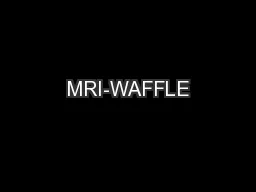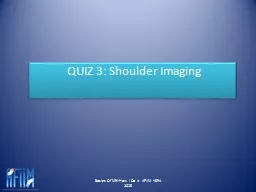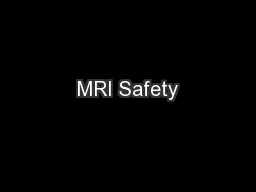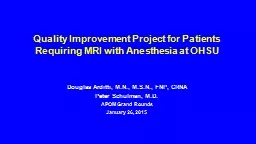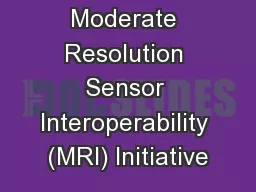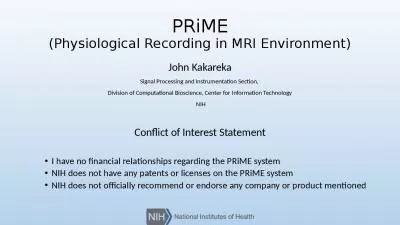PDF-MRI Arthrogram Information for Patients Having an MRI ScanWhat is an M
Author : lydia | Published Date : 2022-08-16
Magnetic Resonance Imaging MRI is a painless and harmless examination This type of scan uses a powerful magnetic field and radio frequencies It does not use Xrays
Presentation Embed Code
Download Presentation
Download Presentation The PPT/PDF document "MRI Arthrogram Information for Patients ..." is the property of its rightful owner. Permission is granted to download and print the materials on this website for personal, non-commercial use only, and to display it on your personal computer provided you do not modify the materials and that you retain all copyright notices contained in the materials. By downloading content from our website, you accept the terms of this agreement.
MRI Arthrogram Information for Patients Having an MRI ScanWhat is an M: Transcript
Magnetic Resonance Imaging MRI is a painless and harmless examination This type of scan uses a powerful magnetic field and radio frequencies It does not use Xrays It isa technique that allows do. ) . and hypokineses.. Cardiac MRI demonstrating LV ejection fraction 49%(57-77), RV ejection fraction 31% (47-67%. ) . and . hypokineses. .. Cardiac MRI demonstrating LV ejection fraction 49%(57-77), RV ejection fraction 31% (47-67%. QUIZ 1. :. . Sequences. Basics Of MRI:How I Do It AFIIM -ISRA 2015. QUIZ 1. :. . Sequences. MRI technique . is. . based. on. Ionizing. radiation . imaging. Magnetic. . field. and . ionizing. CHRISTINA SIEBENEICHER. ANIMAL HISTORY-SIGNALMENT. Waffle is a 8 year old spayed female dachshund. Over the past few months waffle has been trouble getting around and yelps in pain when picked up. Waffle can no longer jump onto the couch and doesn’t want to go on her nightly walks anymore. QUIZ. 3. : . Shoulder. Imaging. What is the . mean goal of . T1WS ?. :. A : to analyze the . trophicity. and . /or the fatty . degeneration of the . muscles . of rotator cuff. Magnet Type. The MRI magnet used at MCH is the superconducting type. Superconducting magnets use a special wire which loses all resistance when cooled to -270 degrees Centigrade. This requires liquid helium to surround the magnet wire. Current is applied to the wire during instillation, which generates the magnetic field as it flows. Superconducting magnets are normally FULLY ENERGIZED at all times.. Douglas Arditti, M.N., M.S.N., FNP, CRNA. Peter Schulman, M.D.. APOM Grand Rounds. January 26, 2015. What is the average delay for the time an MRI is scheduled and the actual time it begins?. How long does it take to start an MRI after induction of anesthesia?. Jenn Lacey, USGS (LSI-VC Co-Lead). 2017 CEOS Chair Initiative. SIT. -32 . Agenda Item. #10. ESA Headquarters – Paris, France. 25. th. -27. th. April 2017. Committee on Earth Observation Satellites. arthrogram C: or T2W MR Arthrogram. Coronal T1-weighted MR arthrogram with fat suppression. E& F: . Sagittal fast spin echo PD-weighted MR image with fat suppression . Introduction You have been advised by your doctor to have a MRI arthrogram. This leaflet will explain what the examination involves. It may not answer all your questions, so if you have any que ries test that helps doctors look for and treat many different medical problems. MRI scanners use a strong magnetic field and computers to create detailed pictures. For an MRI arthrogram , a small a Arthrogram Shoulder Arthrogram 73040 X - ray Shoulder Arthrogram 73222 MRI Shoulder Arthrogram 73201 CT Shoulder Arthrogram Hip Arthrogram 73525 X - ray Hip Arthrogram 73722 MRI Hip Arthrogram 73701 C A108 of Femoral Head Banuprakash S 1 1 Associate Professor, Department of Radio-Diagnosis, Sri Siddhartha Medical College, Agalakote, B H Road, Tumkur- 572107, India Corresponding author: Dr Banupra 367 Rectal cancer is prone to local recurrence and systemic metastasis. However, owing to improvements in TNM staging and treatment, diologist awareness of the key rectal cancer TNM staging features, John Kakareka. Signal Processing and Instrumentation Section, . Division of Computational Bioscience, Center for Information Technology. NIH. Conflict of Interest Statement. I have no financial relationships regarding the .
Download Document
Here is the link to download the presentation.
"MRI Arthrogram Information for Patients Having an MRI ScanWhat is an M"The content belongs to its owner. You may download and print it for personal use, without modification, and keep all copyright notices. By downloading, you agree to these terms.
Related Documents



